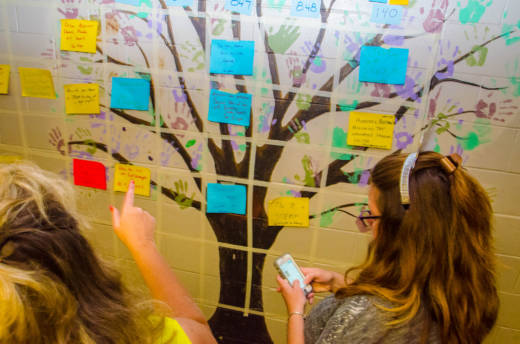Technically, if one trusts the etymology, the best way for a teacher to confer with other educators would be an educator conference. Unfortunately, it’s often obligatory to passively listen to speeches and then “talk to someone next to you” about a prescribed topic. Meanwhile, the most enthusiastic listeners whisper to each other, or form mini-groups outside the conference walls, maybe even at a social gathering later that day. Even if it’s standard professional development at a school site, the richest conversations are usually right afterward or just outside. One administrator even told me, “We don’t ever make any important decisions until we’ve re-discussed them at a bar or coffee shop. That’s where the truth comes out.”
Generally speaking, unconferences offer as much expertise as a more conventional conference, but they’re cost-free, with no salespeople, and the participants propose the topics on the spot and drive the conversations.
Unconferences lack a formal hierarchy and the space is open for different people to be heard and appreciated regardless of where they came from. During the lunch break of the most recent unconference in my area, I asked several of the participants about their experiences in the morning. One district employee was smiling about how there were elementary and secondary teachers connecting and sharing: “Where else do you see this?” he asked. Another participant shared a scene from one of her sessions: “Someone said, ‘I’m just a para…,’ and we were like, ‘You’re never just an anything. We really wanted to hear her perspective.”
To be fair, the morning wasn’t perfect for everyone, and the spontaneous nature of unconferencing results in some unsatisfying conversations. The session on grant writing, for example, was a dud because everyone there wanted to learn how to write them and nobody knew where to start. One teacher went to a “STEM/STEAM” session but was disappointed that the discussion was so “general and theoretical,” while he was looking for something more specific and practical. In these cases, however, attendees are encouraged to use the “Rule of Two Feet” to get up and move on to a new session. The session on grant writing, for example, promptly disbanded and they each found new groups; the “STEM/STEAM” teacher left and went to a group on “buy-in” that he “absolutely loved.”
Because unconferences are unscripted by nature, it’s relatively easy to participate, or even start one of your own, at whatever size is best for you. Even if you send out a group email for people to meet at a coffee shop on a particular afternoon, you’re technically starting an unconference. If you’re looking for something more formal, the same kind of gathering can take place at a school site, ideally one with Wi-Fi and at least a few accessible classrooms. Or if you want go big, you can create a countywide event, complete with a website, advertising and a registration process. I’ve experienced all three types, and they all have their own strengths and deficiencies.


